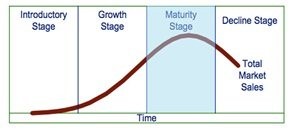Mature Market
A Mature Market is one that has reached a state of equilibrium. A market is considered to be in a state of equilibrium when there is an absence of significant growth, or a lack of innovation. There is stagnation in growth at this time. When supply matches demand the price decided by the market forces of demand and supply is called equilibrium price. Equilibrium price prevails in the market for a substantial period which may be from one day to one week or several months. The market may remain in this state for many years only to decline and eventually fade away. How organizations handle this stage of the market life cycle will determine how much more time they have left in the field.[1]
How Organizations Can Grow in a Mature Market[2]
Here are four steps organizations can take to successfully increase sales and expand market share during the maturity stage.
- Target a particular market segment, preferably the highest spenders. An organization will have multiple market segments they cater to. It makes sense to target various types of consumers during the introduction and growth stages. However, during the maturity stage when sales slow, it makes sense to redouble efforts on the segment providing the highest earnings. By repositioning the product or providing better promotional offers, organizations can spark an interest in this segment by their customer base.
- Focus on your cash cows. Your cash cows are the products that have withstood the test of time and are still bringing in profits. While your star products may be profitable only for a short duration, the cash cows provide a steady flow of income in the long run. Identify these products and invest more monetary and human resources in promoting these products. The one thing managers must remember is that the maturity period is when the late adopter segment may choose to engage with the organization. The cash cow products, being some of the longest surviving products, will be known to the customer, making them the choice of purchase.
- Redesign your product. Despite being in the slow-growth maturity stage, the organization still has a chance to acquire new customers. Product redesigning will help give a fresh look to old products, which will create new appeal for customers. Change the packaging, increase or decrease the size of the product, add a new feature – there are multiple things that organizations can do to existing products to help them generate sales out of the declining market.
- Invest in research and development. Apart from redesigning existing products, adding new products to your portfolio can give you a competitive edge. But one thing to remember is that successful new product development during the maturity stage is largely dependent on the size of the organization, existing resources, duration of time spent in the current market and the needs of the customer base.
Create a complementary or a supplementary product or offer a service that will add more value to the product you are selling. Conduct market research and ask customers for their input. By investing in R&D, you can end declining sales.
Example[3]
When the market for Toyota Corolla swift matured, company came out with new Toyota Corolla. After successfully working for 5-6 years Toyota Corolla had entered into a maturity stage, the demand for the car stabilized and later started decreasing. To increase the interest of the people in the car and market share of the product Maruti, Toyota launched new version. What this effectively did is that it increased the life of swift as a brand and pushed it back into early maturity or late growth stage from late maturity or early declining stage. And thus Toyota Corolla got revived by its new variant.
References
- ↑ Definition - What Does Mature Market Mean? https://www.definitions.net/definition/mature+market Definitions.com]
- ↑ How can organizations grow and survive in the maturity stage? Business.com
- ↑ Example of Toyota dealt with market maturity of Corolla Swift MBASkool

